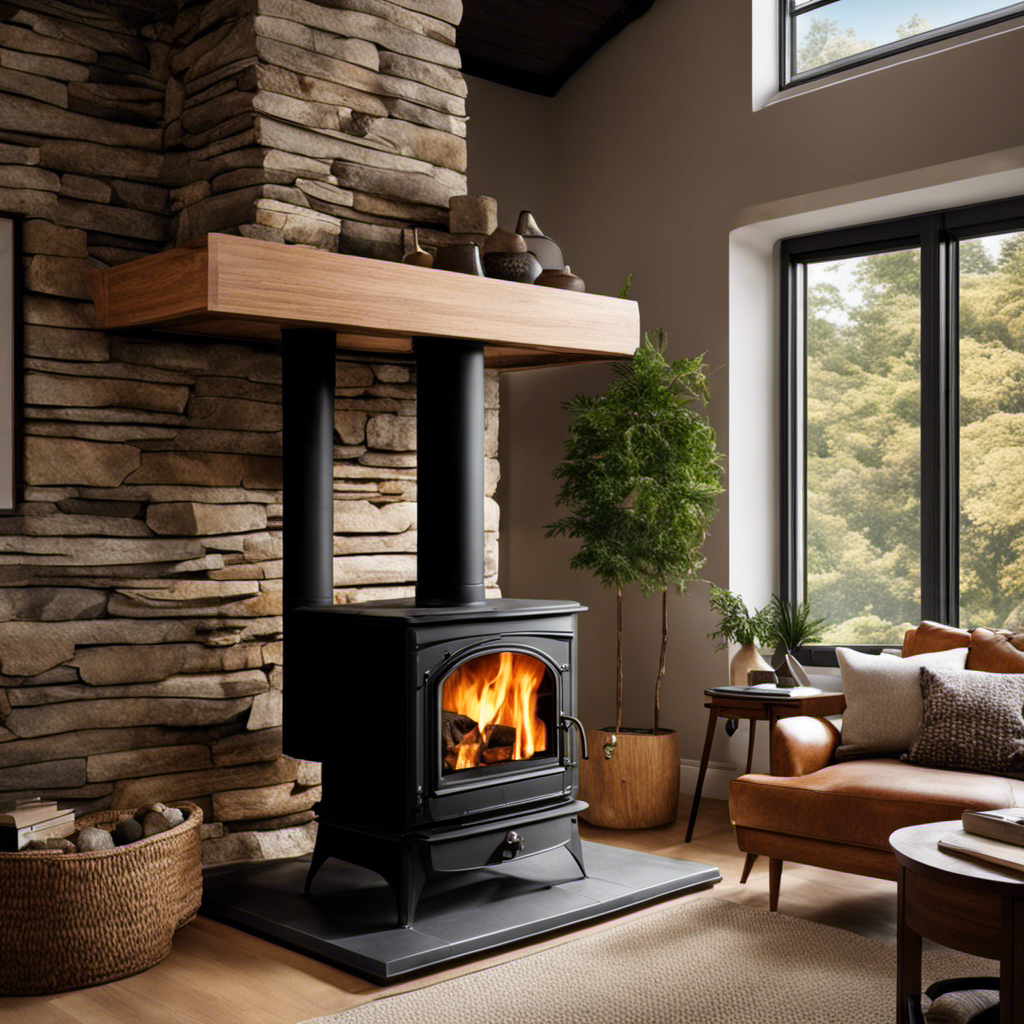I thought that getting a fire going in a new wood stove would be easy. I couldn’t have been more mistaken! It took me some time to learn how to choose the correct firewood, prepare the firebox correctly, and create a good fire layout.
But now that I’ve got the hang of it, I want to share my tips with you. In this article, I’ll show you the step-by-step process of igniting and controlling a fire in a new wood stove.
Let’s get started!
Key Takeaways
- Select seasoned firewood for easier burning and more heat production
- Properly prepare the firebox by cleaning out ashes, arranging kindling, and stacking larger logs
- Build a proper fire lay by gradually adding small tinder and larger kindling, ensuring stability and airflow
- Ignite the fire by arranging dry kindling, adding crumpled newspaper, and using a match or lighter
Selecting the Right Firewood
I typically prefer to use at least three different types of firewood when selecting the right kind for my wood stove.
The first thing I consider is whether the firewood has been properly seasoned. Seasoning firewood is crucial because it ensures that the wood has a low moisture content, making it easier to burn and produce more heat. I look for firewood that has been seasoned for at least six months to a year.
Another important factor is proper firewood storage. It’s essential to store firewood in a dry and well-ventilated area, away from the ground. This helps to prevent the wood from absorbing moisture and becoming less effective as a fuel source.
Preparing the Firebox
To prepare the firebox, I’ll gather both kindling and larger logs to create a well-balanced fire. Here are the steps I take to ensure a successful fire:
-
Clean out any ashes or debris from the previous fire. This is important for proper airflow and to prevent any potential hazards.
-
Arrange the kindling in a crisscross pattern at the bottom of the firebox. This will allow for better ignition and airflow.
-
Place a few fire starters on top of the kindling. These can be small pieces of wood, newspaper, or commercially available fire starters.
-
Carefully stack larger logs on top of the kindling and fire starters, making sure to leave enough space for air circulation.
By following these steps, you can create a solid foundation for building a proper fire lay.
Now, let’s move on to the next section and discuss how to build the fire lay for optimal heat and efficiency.
Building a Proper Fire Lay
Now, let’s dive into the details of building a proper fire lay and see how it can significantly improve the heat and efficiency of your fire.
Building a fire lay is crucial for fire safety and ensuring that your fire burns efficiently. One of the most common mistakes to avoid is piling up too much wood all at once. It’s important to start with small pieces of tinder, such as dry leaves or twigs, and gradually add larger pieces of kindling. This allows for proper airflow and helps the fire catch on easily.
Another tip for fire safety is to ensure that the fire lay is stable and secure, so that it doesn’t collapse or spread uncontrollably.
Igniting the Fire
The key to igniting the fire is using a small amount of newspaper as tinder to get the flames going. Here are some tips to help you start a fire in a new wood stove:
-
Prepare the stove: Make sure the damper is open and the stove is clean and free from any debris or obstructions.
-
Arrange the kindling: Place a small pile of dry kindling in the stove, ensuring proper airflow for efficient burning.
-
Add the newspaper: Crumple a few sheets of newspaper and place them on top of the kindling. This will help create a small initial flame.
-
Light the fire: Use a match or a lighter to ignite the newspaper. Once the flames start, slowly add more kindling and small pieces of firewood to build the fire.
Remember to always follow fire safety guidelines and be cautious when starting a fire. If you experience any issues or difficulties, consult the troubleshooting section in your stove’s manual or seek professional assistance.
Maintaining and Controlling the Fire
As I carefully adjust the damper, I can ensure that the fire in my wood stove remains controlled and maintained. Controlling airflow is crucial in maintaining a steady and efficient fire. By adjusting the damper, I can regulate the amount of oxygen that enters the stove, which directly affects the intensity of the fire. Too much airflow can result in a roaring fire, while too little can cause the fire to smolder and go out. Managing ash buildup is also important for maintaining a healthy fire. Regularly removing ash from the stove helps to prevent airflow restrictions and allows for proper ventilation. By controlling airflow and managing ash buildup, I can enjoy a warm and cozy fire in my wood stove.
| Controlling Airflow | Managing Ash Buildup | Benefits |
|---|---|---|
| Adjusting the damper | Regularly removing ash | Maintains a steady fire |
| Regulates oxygen intake | Prevents airflow restrictions | Ensures efficient burning |
| Controls fire intensity | Allows for proper ventilation | Creates a warm and cozy atmosphere |
Conclusion
Starting a fire in a new wood stove requires careful preparation and attention to detail. By selecting the right firewood, preparing the firebox, building a proper fire lay, and igniting the fire correctly, you can ensure a safe and efficient fire.
Once the fire is burning, it’s important to maintain and control it properly to maximize heat output and minimize smoke. With these steps, you’ll be able to enjoy the warmth and comfort of your new wood stove.
Growing up surrounded by the vast beauty of nature, Sierra was always drawn to the call of the wild. While others sought the comfort of the familiar, she ventured out, embracing the unpredictable and finding stories in the heartbeat of nature.
At the epicenter of every remarkable venture lies a dynamic team—a fusion of diverse talents, visions, and passions. The essence of Best Small Wood Stoves is crafted and refined by such a trio: Sierra, Logan, and Terra. Their collective expertise has transformed the platform into a leading authority on small wood stoves, radiating warmth and knowledge in equal measure.











